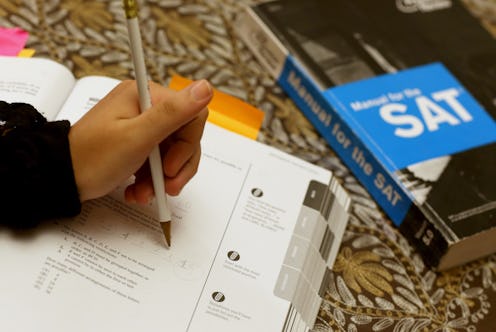News
The SAT Is Adding A New Score To Factor In Students' Background & Privilege

In the near future, students' SAT scores will take more than their academic performance into account, the Wall Street Journal reports. The College Board, which creates and administers the SAT, has added what they call an "Adversity Score" to factor in students' socioeconomic background. Although the full details of how the SAT Adversity score works haven't been revealed, the College Board did explain some components of it to the Journal.
"There are a number of amazing students who may have scored less [on the SAT] but have accomplished more," College Board CEO David Coleman told the Journal. "We can't sit on our hands and ignore the disparities of wealth reflected in the SAT."
According to the Journal, students who take the SAT will be given an Adversity Score between 1 and 100 alongside their raw SAT score, with a higher score indicating more adversity and a lower score indicating less. The score is based on 15 factors, the Journal reports, such as the crime and poverty rates at a student's school and in their neighborhood. Race is not one of the factors that goes into a student's Adversity Score.
Once calculated, the score will be displayed on something called the Environmental Context Dashboard, according to the Journal, which will also show how a student's SAT score compares with those of their classmates.
The College Board hasn't revealed further specifics as to how the score is calculated. But Coleman told the Journal that information about students' backgrounds will be pulled from publicly-available data, such as the census, as well as from sources proprietary to the College Board. Students won't be allowed to view their own Adversity Scores, but the colleges they apply to will. However, college administrators will not be required to take the Adversity Score into account when admitting or rejecting any given student.
The Journal reports that 50 colleges began using the Adversity Score as a part of a trial run in 2018. It will be expanded to 150 schools in the fall, according to the Journal, then rolled out widely in 2020.
Though this might be the first time you've heard the new score mentioned, it's not a brand new concept. The College Board actually began developing the Adversity Score in 2015 in response to colleges' requests for more information about students' backgrounds, Connie Betterton, VP for higher education access and strategy at the College Board, told the Journal.
Yale is just one of the colleges that began taking the Adversity Score into account back in 2018. Jeremiah Quinlan, the dean of undergraduate admissions at the university, told the Journal that Yale has been aiming to make its student body more diverse for years, and that the Adversity Score has been an invaluable tool in helping it accomplish this.
“[It] is literally affecting every application we look at,” Quinlan told the Journal. “It has been a part of the success story to help diversify our freshman class.” As the score is used by more and more schools, you can expect others to share their take on it, too.